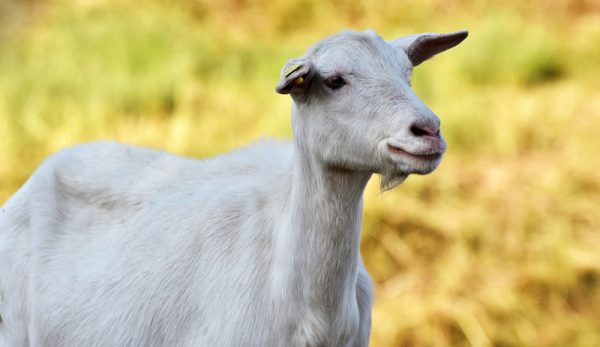
Pregnancy and lactation place extra nutritional demands on your female goats, or does. On average an open doe weight 157 pounds requires 2.76 pounds of dry matter daily, according to the National Research Council.
That jumps to 4.32 pounds during late pregnancy.
“During late gestation, as the kids are growing in the does abdomen, the feed concentrate should increase as the physical gut fill of the rumen decreases,” says Chelsea Hill, livestock and 4-H animal science educator with Penn State Extension, Wayne County.
At this point, you can increase grain or introduce a higher crude protein feed (14 to 16 percent). Combined with higher quality forage, this will meet the dam’s needs. Introduce diet changes slowly, usually over two weeks, to reduce rumen disruption.
“These are general feeding suggestions and vary depending on the quality of forage fed and the feed provided,” she says. “It’s always good for new goat owners to contact either a vet, extension agent or experienced goat owner in their area to see if there are any regional deficiencies that will need to be supplemented.
Read more: Check out these 5 key aspects of feeding goats.
Increasing Nutritional Demands for Goats
Lactation is the most nutritionally demanding stage in a doe’s life. It is during this stage she will lose some of her body condition/body stores to compensate.
While this is a normal part of the process, the goal is to limit weight loss. Starting a lactation diet about five to seven days before her due date can help prepare the body for lactation.
“Depending on the quality of forage, the grain given should be changed to one that is a crude protein of 16 to 18 percent,” Hill says. “The amount given depends on the amount of milk produced by the dam. Meat goats will not require as much as a high-producing dairy goat will unless she is feeding triplets or more.”
Access to fresh and clean water is part of good herd management, but it becomes even more critical during lactation. Water impacts milk production. And does will need a minimum of 3.5 gallons daily.
“Give warm water, usually with some molasses in it right after kidding, to help increase water intake. [This will] assist in replenishing fluids lost as well as aid in the ‘cleaning’ out process,” she says.
Timing for Dropping Rations
Pregnancy and lactation increase the nutritional needs of goats. Dairy goats milked for 10 months with a two-month dry period should remain on their dairy ration up until about month 8. Then, Hill says, evaluate for body condition score.
At this point, if a goat is deeply dropping off on milk production and carrying extra weight (BCS of 3.5 or higher), reduce the ration.
“At the time the doe is to be dried, extra feed given for lactation should be taken away,” Hill said. “It’s around month 7 that the doe should be bred once again, and will start to decline in milk production naturally.”
Conversely, meat goats should stay on their lactation diet as long as they are feeding kids. Then, post-weaning, reduce feed to maintenance to make sure they don’t gain too much weight.
Read more: How long can a dairy goat produce milk without breeding?
Work with an Expert
Depending on the feed and forage available in your region, it’s important to know of any natural mineral deficiencies that can lead to metabolic diseases. In Hill’s area, the two most common are:
- hypocalcemia (a deficit of the calcium required by the dam)
- hypomagnesaemia (a magnesium deficit)
“The calcium to phosphorus ratio in the diet should be as close to 2:1 as possible,” she said. “If the dam is not eating enough calcium during late pregnancy or ingests something blocking calcium absorption, the dam will draw on her bodily stores of calcium until clinical signs of the disease are observed.”
Both conditions can occur in dams on lush green pastures, where lower levels of both minerals are available.
Hypomagnesaemia is hard to catch and usually results in sudden death. Hypocalcemia, however, is treatable—but severe cases need veterinary care for optimal survival rates.
Work with a knowledgeable nutritionist or veterinarian to design a ration. You can meet your herd’s needs based on the supplements, forages and grain you feed.





